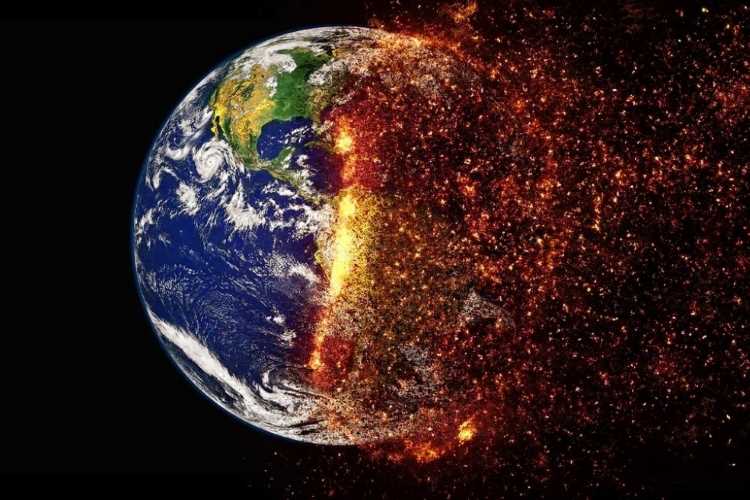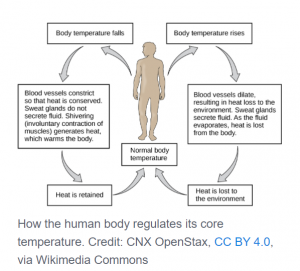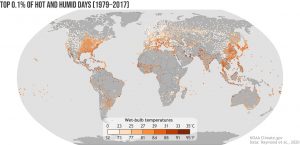
One of the most dangerous manifestations of global warming and climate change is heat stress, which is the single-largest cause of weather-related deaths in the world. As most such extreme weather events go unreported, only a few garner media attention, like the major heat wave that killed hundreds of people in the US Pacific Northwest last summer.
Severe heat waves have become regular affairs over the last 40 years. Medical science is not fully aware of the impact of extreme heat on human health. Extreme heat stress more than doubled in the last four decades and this trend will continue, say experts at NASA’s Jet Propulsion Laboratory. They predict that daily weather forecasts will soon have a ‘heat index’ in addition to temperature and humidity figures. The heat index measures how your body will feel at a particular temperature and humidity. However, there cannot be a single measurement that suits all regions of the world. A globally accepted measure of heat stress is the wet-bulb temperature.
READ I Healthcare spending: Govt focus on sustainable budgeting after Covid-19 shock
Wet-bulb temperature is defined as the lowest temperature to which an object can cool when moisture evaporates from it. Lower wet-bulb temperature means it is easier to lower temperature. In other words, it measures how the human body can cool when it sweats, and whether a heat wave is harmful for one’s health. Though both the heat index and wet-bulb temperature use data on atmospheric temperature and humidity, they use different techniques.


According to NASA’s Jet Propulsion Laboratory scientists, the highest wet-bulb temperature that supports human survival when exposed to it for six hours is 35 degrees Celsius. NASA studies reveal that wet-bulb temperatures are rising across the world and will cross this threshold. The graph below shows the areas where wet-bulb temperature readings exceeded 27 degrees. NASA uses weather stations and a gridded reanalysis product for data. Wet-bulb temperatures exceeding 95 degrees Fahrenheit have been observed for short periods on nine occasions. The concern is that such instances are becoming more frequent.
READ I Social security for gig workers of Uber, Ola still a distant dream
Poorer areas bear the brunt of heat stress
The biggest victims of heat waves are developing nations, which are located in the hottest parts of the world. They face a higher risk of dangerous heat waves triggered by global warming and climate change. Exposure to heatwaves has increased in poorer countries in the last 40 years, according to Increasing Heat-Stress Inequality in a Warming Climate, a research study authored by Mohammad Reza Alizadeh, John T. Abatzoglou, Jan F. Adamowski, Jeffrey P. Prestemon, Bhaskar Chittoori, Ata Akbari Asanjan, and Mojtaba Sadegh. Heat hazards intensified during this period and are expected to increase in the future. A factor that needs to be considered is the greater institutional and individual capacity of richer countries to adjust to climate change. The major findings of the study are quite disturbing:
- Heatwave exposure in the last decade was 40% higher in the lowest income regions.
- High-income countries have a better capacity to absorb climate change-driven increases in heatwave exposure.
- The inability of poor countries to adapt to climate change fast enough results in widening heat-stress inequality.
Extreme climate events have caused a global economic loss of $2,245 billion between 1998 and 2017, an increase of 151% over the previous 20 years. More than 1,66,000 people lost their lives to extreme heat waves between 1998 and 2017. The study says poor countries are 2-5 times more exposed to extreme heat waves compared with the rich world.
Climate models show that some regions are likely to exceed the wet bulb temperature threshold in the next five decades. According to NASA, several regions of the Persian Gulf, South Asia and the Red Sea will become uninhabitable by 2050.
Heat waves can result in destruction of crops, livestock and infrastructure. Close to a third of the world population lives in places where heat and humidity levels can be harmful at least some days of the year. These places need cooling centres, home-cooling equipment, and urban designs that reduce heat exposure. However, poor countries may find it difficult to fund such efforts. The study says the poorest quarter of the world lags behind the wealthiest in adaptation by at least 15 years, according to an estimate based on the UN Environment Program’s Adaptation Gap Report.
